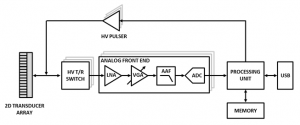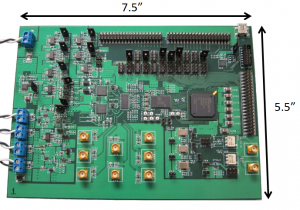An Electronically Steered, Wearable Transcranial Doppler Ultrasound System
- Category: Circuits & Systems, Medical Electronics
- Tags: charles sodini, hae-seung lee, healthcare, sabino pietrangelo
Traumatic brain injury (TBI) occurs in over 1.4 million persons annually in the United States [1] . Monitoring of a patient’s cerebrovascular state following TBI is used in guiding therapy and mitigating secondary injury [2] . Such monitoring, however, often relies on bulky capital equipment and a skilled operator, thus restricting its use to limited clinical environments (typically neurocritical care units). This project seeks to develop a low-power, miniaturized transcranial Doppler (TCD) ultrasound system for measuring cerebral blood flow velocity (CBFV) in support of continuous cerebrovascular monitoring.
The system architecture, as illustrated in Figure 1, employs multi-channel transceiver electronics and a two-dimensional transducer array to permit electronic steering of the ultrasound beam. A first-generation discrete eight-channel TCD prototype is shown in Figure 2. Further revisions of the prototype system will increase channel count for improved beam steering functionality. Advanced beam steering algorithms will allow for autonomous vessel location, thereby obviating the need for manual transducer alignment and operator expertise. The wearable system will permit monitoring of cerebrovascular state in a wide variety of contexts that are currently unfeasible under standard measurement modalities.
- Figure 1: Multi-channel TCD ultrasound system hardware block diagram.
- Figure 2: Discrete eight-channel TCD ultrasound system prototype.
- J. A. Langlois, W. Rutland-Brown, and K. E. Thomas, “Traumatic brain injury in the United States: Emergency department visits, hospitalizations, and deaths,” Centers for Disease Control and Prevention, Atlanta, GA, 2004. [↩]
- M. R. Bullock, J. T. Povlishock, Ed., “Guidelines for the management of severe traumatic brain injury,” Journal of Neurotrauma, vol. 24, Supplement 1, 2007. [↩]

